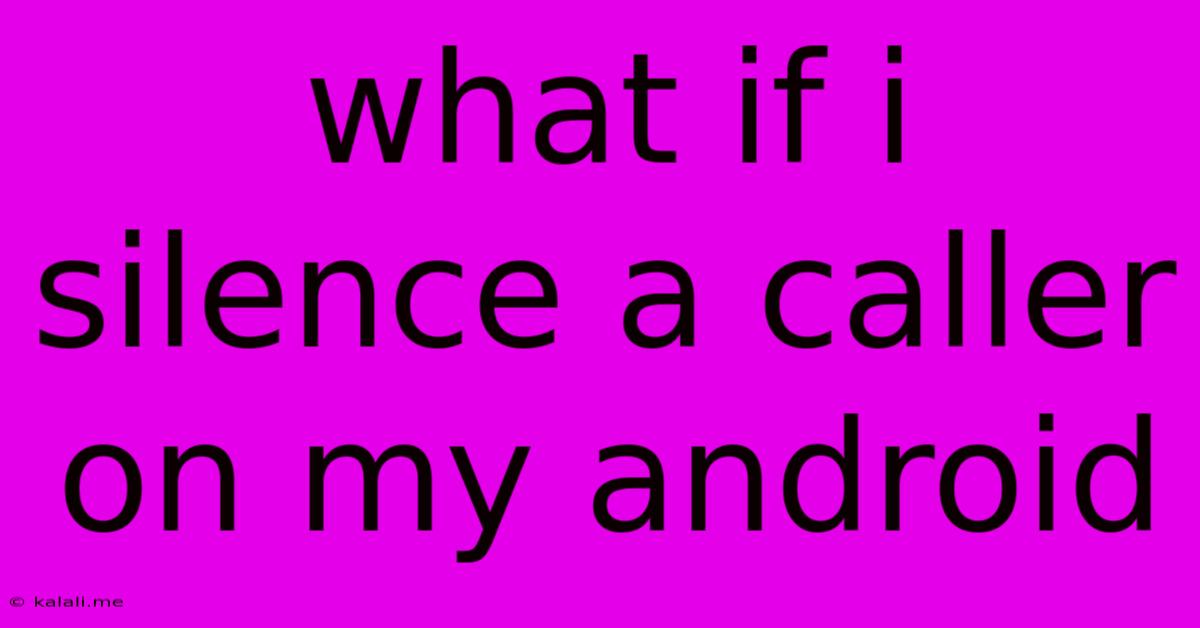What If I Silence A Caller On My Android
Kalali
Jun 09, 2025 · 3 min read

Table of Contents
What Happens When You Silence a Caller on Your Android? Understanding Call Blocking and Silencing
Ever wondered what happens when you silence an incoming call on your Android phone? It's not as simple as just making the ringing stop; different actions have different consequences. This article explores the various ways to silence calls on Android, the differences between silencing and blocking, and what happens to the caller in each scenario.
Understanding the Differences: Silencing vs. Blocking
Many people use the terms "silence" and "block" interchangeably, but there's a key difference. Silencing a call temporarily stops the ringing and notification, but the caller can still reach you. Blocking, on the other hand, prevents the caller from contacting you altogether. The call goes straight to voicemail (if enabled) or is simply rejected.
Methods of Silencing Calls on Android
There are several ways to silence an incoming call on your Android device:
-
Pressing the Volume Down Button: The simplest method. This will mute the ringer, but the call will continue to show on your screen. You can still answer it.
-
Using the "Decline" or "Ignore" Option: This stops the ringing and notification. The caller will likely hear a busy signal or go straight to voicemail, depending on your phone settings. However, they can still try again.
-
Enabling "Do Not Disturb" (DND) Mode: This is a more comprehensive silencing option. DND silences all calls and notifications, except for those you've specifically allowed. This is ideal for meetings or quiet time. You can customize DND to allow calls from specific contacts or groups.
-
Using Third-Party Call Blocking Apps: Many apps offer advanced features beyond the basic Android functionality. These apps allow you to silence specific numbers, keywords, or even unrecognized numbers, providing a more tailored call management experience.
What the Caller Experiences
The experience of the caller depends heavily on your chosen method:
-
Volume Down: The caller will hear your phone ringing, although the volume is reduced.
-
Decline/Ignore: The caller will likely hear a busy signal or a voicemail message, if voicemail is enabled.
-
Do Not Disturb: The caller will likely receive no notification that their call was attempted.
-
Third-Party Blocking Apps: The caller's experience varies according to the app. Some may receive a busy signal, while others might hear nothing at all.
Choosing the Right Approach: Silencing vs. Blocking
The best method depends on your situation. If you're just trying to temporarily mute a ringing phone, pressing the volume down button or using the decline option is sufficient. However, if you need a more permanent solution to unwanted calls, using the blocking feature or a third-party app is more appropriate. Remember, blocking is the more decisive action, permanently preventing the caller from reaching you.
Managing Unwanted Calls Effectively
Managing unwanted calls is an important part of maintaining phone privacy and peace of mind. By understanding the differences between silencing and blocking calls, and by leveraging the various features available on your Android phone and through third-party apps, you can effectively control your incoming calls and prioritize your communication. Consider using a combination of methods – silencing for temporary interruptions and blocking for persistent unwanted callers – to maintain a balance between accessibility and privacy.
Latest Posts
Latest Posts
-
How Did Jacob Not Know It Was Leah
Jun 09, 2025
-
How Much Storage Does Minecrafttake Up
Jun 09, 2025
-
Anime 4 Year Old Boy Blue Hair
Jun 09, 2025
-
Is It Illegal To Own A Crow
Jun 09, 2025
-
Attract More With Honey Than Vinegar
Jun 09, 2025
Related Post
Thank you for visiting our website which covers about What If I Silence A Caller On My Android . We hope the information provided has been useful to you. Feel free to contact us if you have any questions or need further assistance. See you next time and don't miss to bookmark.